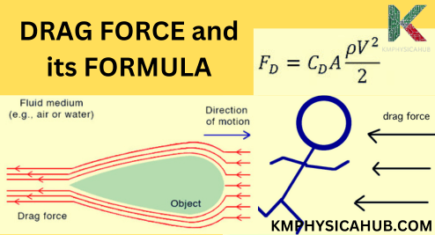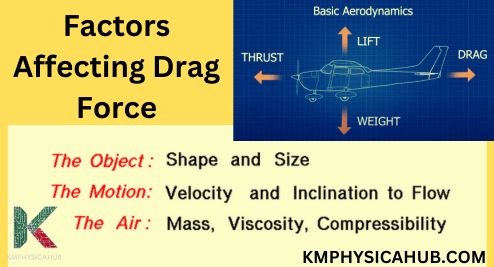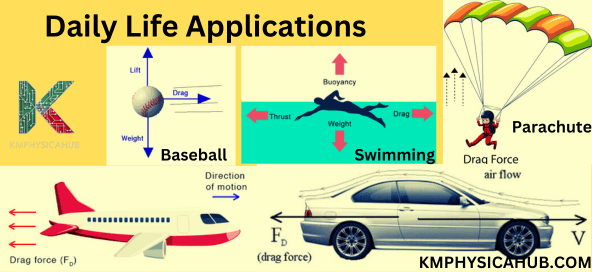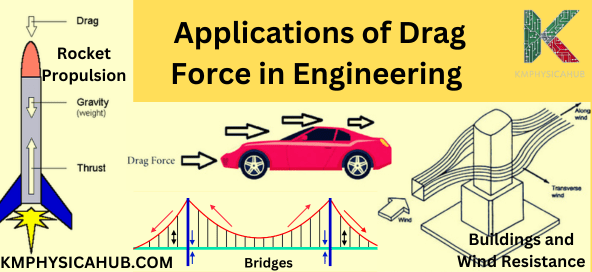Measurement and Reduction of Drag Force for Optimizing Performance
Definition
Think about a car that is in motion or a car driving on the freeway. The object also realizes a force working against it from the onset, thereby reducing its speed as it moves through the air. This force is known as drag force. It is that kind of friction which comes into play when an object is sliding through a medium say fluid which is air water or any other medium.
Mathematical Formula:
F = (Cd A ρ V^2 )/ 2
Physics of Drag Force
Fluid Dynamics:
Drag force is governed by the principles of fluid dynamics, the study of how fluids behave in motion. Key concepts include:
Viscosity:
A measure of how much a fluid opposes the movement of something passing through it. The level of viscosity also influences the drag experienced by the substance; a more viscose substance such as honey will experience more drag than a less viscose substance, water for instance.
Pressure:
Pressure, the amount of force that a fluid exerts per unit of area. Fluid pressure changes as an object moves through it, contributing to drag force.
Flow Separation:
When the flow of the fluid detaches from the surface of the object, turbulent eddies arise which in turn cause an increase in drag.
Reynolds Number:
Reynolds number (Re) is another dimensionless parameter used to understand the nature of the stream around an object. It’s calculated as:
Re = (ρ * v * L) / μ
Where:
ρ = fluid density
v = velocity of the object
L = Object’s characteristic length
μ = dynamic viscosity of the fluid
In low Reynolds number conditions, the flow of the fluid is laminar, or in other words, it is smooth and predictable. If the Reynolds number is high, the flow becomes turbulent as it encounters chaotic currents and more drag is the consequence.
Drag Coefficient:
Cd refers to drag coefficient which is a measure of the shape as well as roughness of the surface of an object. It quantifies how effectively an object cuts through a fluid. The lower value of drag coefficient means less amount of drag force.
The drag coefficient is influenced by factors like:
Shape: Shapes with smooth flowing surfaces aerodynamically have lower drag coefficients than shapes with abrupt surfaces.
Surface roughness: The chances of drag are minimal on a smooth surface than on a rough surface.
Angle of attack: The orientation of the object with regard to the flow influences the drag coefficient.

Factors Affecting Drag Force
Velocity:
Drag force is in direct proportion to the velocity’s square. This means that doubling the velocity quadruples the drag force. This is why drag becomes a major factor at high speeds.
Fluid Density:
Fluid density is in direct proportion to the drag force. High viscous fluids like water are likely to result in the development of the more fluid drag than less viscous fluids such as air. This is why it is notable that any object has more force on it when it is in water than when it is in air.
Surface Area:
The bigger the area of the object that it occupies in the fluid flow, the greater the drag force. For the same reason, cars with a bigger frontal area would experience more drag than the smaller ones.
Shape and Orientation:
The shape and orientation of an object significantly impact drag force. Streamlined shapes, like teardrops or fish, minimize drag, while blunt shapes, like cubes or spheres, experience much higher drag. The orientation of the object also plays a role, with objects facing directly into the flow experiencing more drag than those angled to the flow.
Surface Roughness:
When the surface of the object is rough, the resistance experienced by the fluid along the walls of the object is high, which implies that there is more drag. Rough or irregular surface increase the rate of turbulence in the flow and consequently increase drag while smooth surface reduces turbulence and hence reduces drag.

Importance of Understanding Drag Force
It is significant to understand drag force in various aspects of our lives ranging from scientific and technological aspects to sporting activities and personal experience.
Optimize designs: The knowledge on drag force enables us to have an increased understanding that affects vehicle, building and other structures to enhance energy use and efficiency.
Predict motion: For example, to explain how airplanes fly or how fish swim, or for anything involving weather prediction, understanding drag force is paramount.
Improve efficiency: Reduction of drag force can go a long way to enhance the performance of various systems ranging from wind energy conversion systems, turbines, to drug delivery systems.
Types of Drag Force
Drag force is not a one force that is exerted by the fluid on the object but is in fact a net force made up of different forces produced due to the interaction of the object with the fluid.
Skin Friction Drag:
This happens when the two fluid layers that are in contact with the object or surface undergo a relative motion which causes friction. Visualize the force you feel, when you try to extend your hand through the opened window of a moving car.
Form Drag:
This is drag that occurs due to the shape of the object that is moving through the fluid. This is because objects with broad and sharp edges have higher form drag than smooth objects of streamline shapes. How much would a square mass of metal or any another obstruction offer in terms of resistance compared to a teardrop-shaped object?
Induced Drag:
Drag of this sort is unique to objects with lifting surfaces, that is, wings of airplanes. It is created by the formation of lift, and it varies with the size of the lift created.

Applications of Drag Force in Daily Life
Transportation:
-
Airplanes and Cars:
Aerodynamics and Streamlining: Aerodynamic forces can be seen in the engineered shapes of various vehicles such as the streamlined shapes of the cars and aircraft that are intended to reduce the force of drag in order to maximize fuel efficiency. Simplified shapes also help decrease turbulence, and thus, decrease drag or air resistance.
Examples: The teardrop shape of an airplane fuselage and the curves of a modern car are two clear examples of aerodynamic design for the purpose of reducing drag.
-
Parachutes and Skydiving:
Controlled Descent: Parachutes offer wide fabric area and they cause drag force which helps in reducing the free falling speed of the skydivers. Parachute has a particular form and fabric which permit it to give controlled fall in addition to a protected landing.
Example: The technology has advanced and hence the structure of the parachute has also changed, the improved design has better materials and the shape of the chute is more stable and better controllable.
Sports:
-
Swimming and Water Resistance:
Water Resistance: Water exert force of drag on swimmers and this depends on the speed of the swimmer and size or the surface area that is exposed to the water. In swimming, swimmers make use of some methods that will reduce the drag force such as streamline and fast swimming strokes.
Examples: Materials and texture on swim suits that can cause less resistance when propelled through the water draw less drag force. The use of dolphin kick and streamlined body formation also reduce water drag.
-
Baseball and Aerodynamics:
Aerodynamics: The kind of baseball grip and spin on the ball determines the different trajectory and manner of flying of the baseball. The spin consequently forms the Magnus effect which give the ball a curved trajectory and hence difficult to be hit by the batters.
Examples: Most of the pitched deliveries made by pitcher involve the use of curve balls, sliders among others whereby the motion of the ball involves considerable deflection due to principals of aerodynamics.

Nature:
-
Birds and Flight:
Aerodynamic Lift: As seen with the bird where the wings are used to produce the lift to act against the force of gravity and allow the bird to fly. This explains the overall design and flapping of the wings since its movement leads to generation of pressure difference that leads to formation of lift.
Examples: Thus, some bird species acquired more optimal wings and ways of flight for the purpose of enhancing their flight capabilities and versatility.
-
Fish and Water Resistance:
Streamlined Bodies: Fish are one good example where drag force is a challenge and hence their bodies have been shaped to be as streamlined as possible in water. These streamlined, elongated structures with thin tails and fins allow the sharks efficient swimming in the water.
Examples: Like any fast and flexible swimmer, sharks have scales on their skin reducing friction and turbulence to as low level as possible.
Engineering Applications of Drag Force
Aerospace:
-
Designing Aircraft and Spacecraft:
Aerodynamic Efficiency: Aircrafts have smooth shapes and wings which as mentioned bear the lift of the aircraft and are also as thin as possible to reduce drag. This helps to facilitate smooth flight and minimize fuel consumption.
Examples: Among recently built aircraft, the Boeing 787 Dreamliner has improved fuel efficiency and incorporates winglets and a low resistance body.
-
Rocket Propulsion:
Thrust and Drag: Rocket propulsion involves working on the basis of Newton’s third law of motion where one body exerts an equal force on another body in opposite direction. So the expulsion of the exhaust gasses happens to be the reaction force. Drag impacts the acceleration of the rocket and its functionality by acting against the direction of the rocket’s motion.
Examples: Rocket designs incorporate features like streamlined nose cones and fins to minimize drag and optimize thrust for efficient space travel.
Civil Engineering:
-
Bridge Design and Wind Loads:
Structural Integrity: Wind loads also affect the safety of bridges and so proper consideration must be made when designing the bridges to ensure that they are able to handle wind loads that will exert a certain amount of force on the bridge. It therefore becomes very important to assess the drag force because it determines the level of stability of the bridge as well as its ability to withstand force.
Examples: The type of bridges such as the Golden Gate Bridge are made with cables and towers which have more like streamlined shape in order to minimize the force arising from wind and other factors while maintaining stability in force.
-
Building Design and Wind Resistance:
Wind Resistance: Wind load is an external force that must be considered for structures because it may lead to harm the structures and can even come with destructive consequences such as the collapse of the building. Buildings that are low and have compact shape with lesser spaces between windows are more resilient to winds.
Examples: The design of tall buildings like skyscrapers feature rounded corners and wind resistant skins as they experience drag force due to high velocity winds.

Mechanical Engineering:
-
Designing High-Speed Vehicles:
Aerodynamics and Drag Reduction: Fast-moving vehicle, including the train and race car, have smooth body shapes and perfected for aerodynamics, enabling reduction in force due to drag.
Examples: For instance, the bullet trains have smooth bodies with pointed front ends known as noses in an effort to minimize air drag and thus reach top allowable speed.
-
Optimizing Fluid Flow Systems:
Fluid Resistance: Drag force is a significant factor in fluid flow systems, such as pipelines and pumps. Understanding drag force allows engineers to optimize system efficiency and minimize energy losses.
Examples: Pipeline designs incorporate features like smooth internal surfaces and optimized pipe diameters to reduce friction and improve fluid flow.
Medical Applications of Drag Force
Drug Delivery:
-
Targeted Drug Delivery Systems:
Drug Transport: Drag force plays a crucial role in drug delivery systems, affecting the transport of drugs through the body. Understanding drag force helps design targeted drug delivery systems that reach specific areas.
Examples: Nanoparticles and microparticles are designed to carry drugs to specific target sites, minimizing drag force in specific body fluids to achieve targeted delivery.
-
Microfluidics and Drug Transport:
Fluid Flow Control: These systems include drug delivery and diagnostic systems, which require great control of fluids through channels in microfluidic devices. Drag force is important for the flow patterns of fluids with the devices.
Examples: Microfluidic chips are engineered to manipulate healing fluids and dispense drugs in a particular way , with consideration being taken on drag forces and fluid dynamics.
Biomechanics:
-
Movement of Blood Through Blood Vessels:
Blood Flow Resistance: Drag force plays an important role in flow rate of blood through blood vessels. This is important to know, particularly about blood pressure, blood flow and cardiovascular physiology in general.
Examples: Knowledge about drag force kinematics aids in the design and development of artificial heart valves and other devices used in medical operations involving blood circulation.
-
Sports Medicine and Injury Prevention:
Biomechanical Analysis: Appreciation of drag forces in this regard assists in sports medicine and injury prevention among humans during their movement. Understanding the loads that affect athletes’ bodies, while performing these activities, may help enhance their preparation process and minimize the possibilities of injuries.
Examples: In running, it is possible to examine the gait pattern of runners and determine any issues that could cause a breakdown or injury. Analyzing drag forces in swimming can help in minimizing the forces that affect shoulders or back thus preventing injury.
Measurement of Drag Force
Wind Tunnels:
Wind tunnels are facilities especially designed to measure force of resistance exerted by air on objects. They use wind tunnels to build airflow around a model which has the object to be tested to determine the forces involved. Wind tunnels are very important for the planning of different vehicles like aircraft and cars. They are influential in regard to providing data for the optimization of aerodynamic performance.
Computational Fluid Dynamics (CFD):
The computational fluid dynamics (CFD) is an important tool for simulating the flow of fluids and calculating the drag force. CFD involves the use of mathematical formulas and computational geometry in making calculations on the behavior of the fluid about the object. It also gives engineers the possibility to compare many design configurations in order to minimize the drag forces without rebuilding models in physical tests.
Methods for Reducing Drag Force
Streamlining:
Aerodynamic thrust force is the force an object experiences in the downstream direction and streamlining is the process of designing an object to reduce the drag force. Aerodynamic shapes, also known as streamlined shapes, have curved surfaces that offer the least amount of resistance to the fluid’s movement. This is why object such as airplanes, automobiles, and bullets are made to have sleek shapes.
Surface Coatings:
It is possible to reduce the drag force by applying certain coatings on the surfaces.
Hydrophobic: Effectively repel water and thus cuts the drag especially in aquatic conditions.
Friction-reducing: Reduce the skin friction drag by minimizing the resistance that the surface opposes to any flow of fluids across it.
Turbulence-suppressing: This helps in reducing the formation of turbulent eddies affecting the drag.
Active Drag Reduction
Dynamic drag reduction involves technologies that either change the contour of the body or flow field around it while in operation.
Adaptive Spoilers: These are loosely mounted parts situated on the car’s body which are able to change their direction in relation to the airflow so as to minimize air resistance during high speed.
Active Flow Control: Actuators are employed in this technology to control the flow of air about the object in a manner that is strong enough to prevent flow separation and subsequently drag.
Conclusion:
Drag force is a type of force which works on an object in a fluid, and it is one of the basic forces involved in fluid dynamics. Knowledge of drag force in physics and how this force affects systems and how it can be minimized is useful in the designing of vehicles, games equipment, and other machines. Efficiency is a critical factor where drag reduction is inevitable, and it is due to streamlined shapes, surface coatings, and active drag-reduction technologies.
Research on drag force continues to advance, with ongoing efforts to develop new materials, coatings, and active drag reduction systems.
FAQs
Q1. What is drag force?
A: Drag force is the amount of force that acts on the object to slow it down or prevent it from moving through a fluid. It opposes the object’s motion.
Q2. What factors affect drag force?
A:
- Speed: Higher speed, higher drag.
- Shape: Streamlined shapes minimize drag.
- Fluid Density: Denser fluids like honey can create more drag force.
- Surface Area: Larger surface area exposed to the fluid, higher drag.
Q3. Why is minimizing drag important?
A:
- Efficiency: Less energy wasted fighting resistance, improving fuel economy in vehicles.
- Performance: Faster speeds, better maneuverability in sports and aerospace.
- Safety: Reducing wind loads on structures, minimizing erosion.
Q4. How can we reduce drag?
A:
- Streamlining: Designing objects with smooth, tapered shapes.
- Surface texture: Using materials that minimize friction.
- Reducing surface area: Reducing the size of the surface area which faces the wind directly.
Q5. Give some examples of drag force in daily life?
A:
- Wind resistance on a bicycle.
- Water resistance on a swimmer.
- Air resistance on a car.
- Parachutes slowing a skydiver’s descent.